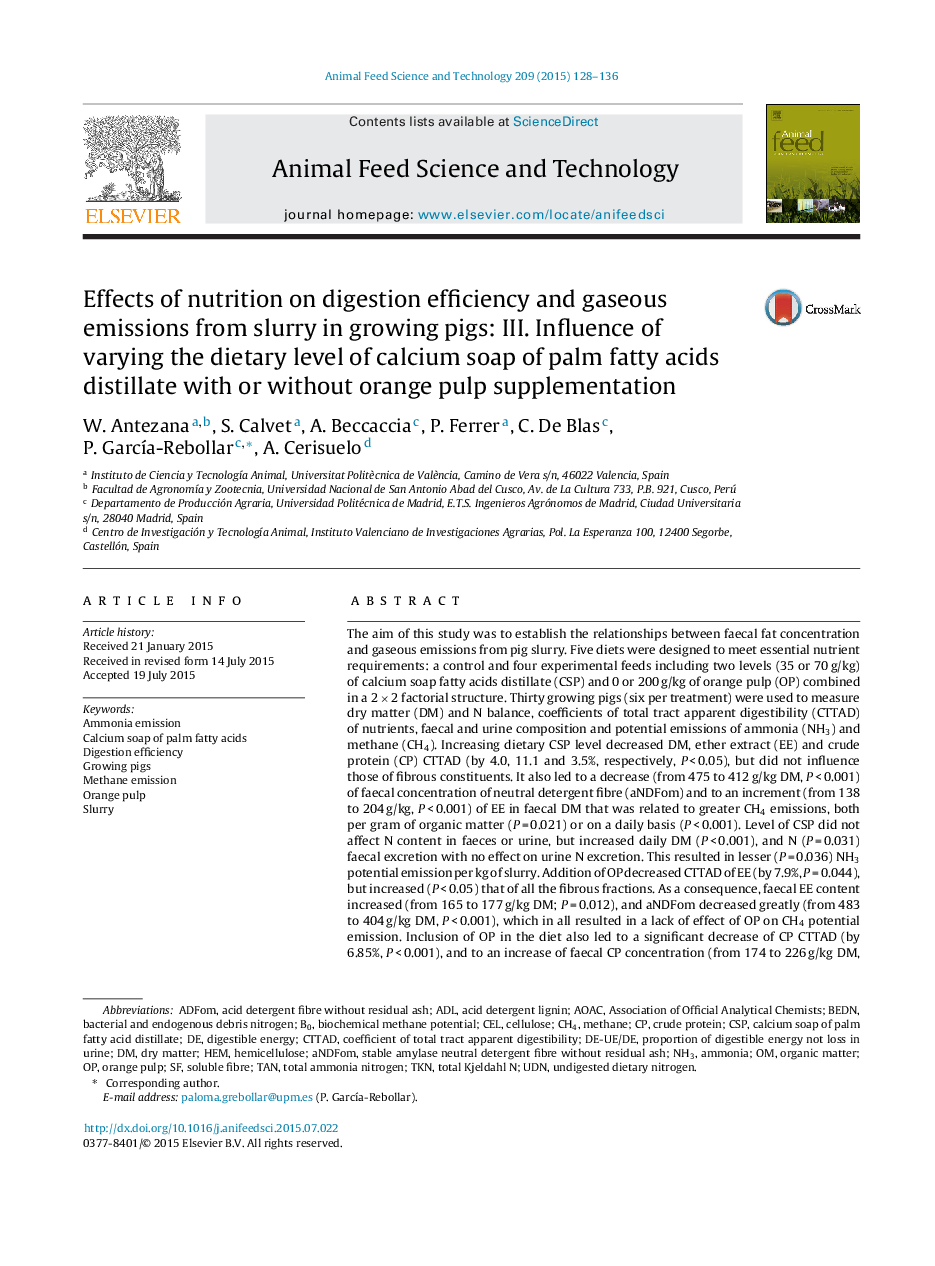| کد مقاله | کد نشریه | سال انتشار | مقاله انگلیسی | نسخه تمام متن |
|---|---|---|---|---|
| 2419378 | 1552376 | 2015 | 9 صفحه PDF | دانلود رایگان |

• Understanding factors of variation of slurry composition can help to predict gaseous emissions.
• Nutritional strategies are effective inducing changes in excreta characteristics.
• Addition of CSP increased faecal EE, CP content and CH4 emission, but reduced NH3 production/kg slurry.
• Inclusion of OP altered faecal composition but did not affect emissions from slurry.
The aim of this study was to establish the relationships between faecal fat concentration and gaseous emissions from pig slurry. Five diets were designed to meet essential nutrient requirements: a control and four experimental feeds including two levels (35 or 70 g/kg) of calcium soap fatty acids distillate (CSP) and 0 or 200 g/kg of orange pulp (OP) combined in a 2 × 2 factorial structure. Thirty growing pigs (six per treatment) were used to measure dry matter (DM) and N balance, coefficients of total tract apparent digestibility (CTTAD) of nutrients, faecal and urine composition and potential emissions of ammonia (NH3) and methane (CH4). Increasing dietary CSP level decreased DM, ether extract (EE) and crude protein (CP) CTTAD (by 4.0, 11.1 and 3.5%, respectively, P < 0.05), but did not influence those of fibrous constituents. It also led to a decrease (from 475 to 412 g/kg DM, P < 0.001) of faecal concentration of neutral detergent fibre (aNDFom) and to an increment (from 138 to 204 g/kg, P < 0.001) of EE in faecal DM that was related to greater CH4 emissions, both per gram of organic matter (P = 0.021) or on a daily basis (P < 0.001). Level of CSP did not affect N content in faeces or urine, but increased daily DM (P < 0.001), and N (P = 0.031) faecal excretion with no effect on urine N excretion. This resulted in lesser (P = 0.036) NH3 potential emission per kg of slurry. Addition of OP decreased CTTAD of EE (by 7.9%, P = 0.044), but increased (P < 0.05) that of all the fibrous fractions. As a consequence, faecal EE content increased (from 165 to 177 g/kg DM; P = 0.012), and aNDFom decreased greatly (from 483 to 404 g/kg DM, P < 0.001), which in all resulted in a lack of effect of OP on CH4 potential emission. Inclusion of OP in the diet also led to a significant decrease of CP CTTAD (by 6.85%, P < 0.001), and to an increase of faecal CP concentration (from 174 to 226 g/kg DM, P < 0.001), with no significant influence on urine N content. These effects resulted in higher N faecal losses, especially those of the undigested dietary origin, without significant effects on potential NH3 emission. No significant interactions between CSP and OP supplementation were observed for the gaseous emissions measured.
Journal: Animal Feed Science and Technology - Volume 209, November 2015, Pages 128–136